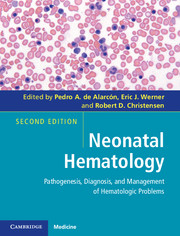Book contents
- Frontmatter
- Contents
- Contributors
- Foreword
- Preface
- 1 A historical review
- Section I Developmental hematology
- Section II Erythrocyte disorders
- Section III Platelet disorders
- 10 Fetal and neonatal immune thrombocytopenia
- 11 Acquired thrombocytopenia
- 12 Congenital thrombocytopenias and thrombocytopathies
- Section IV Leukocyte disorders
- Section V Immunologic disorders
- Section VI Hemostatic disorders
- Section VII Transfusional medicine
- Section VIII Miscellaneous
- Index
- Plate section
- References
10 - Fetal and neonatal immune thrombocytopenia
from Section III - Platelet disorders
Published online by Cambridge University Press: 05 February 2013
- Frontmatter
- Contents
- Contributors
- Foreword
- Preface
- 1 A historical review
- Section I Developmental hematology
- Section II Erythrocyte disorders
- Section III Platelet disorders
- 10 Fetal and neonatal immune thrombocytopenia
- 11 Acquired thrombocytopenia
- 12 Congenital thrombocytopenias and thrombocytopathies
- Section IV Leukocyte disorders
- Section V Immunologic disorders
- Section VI Hemostatic disorders
- Section VII Transfusional medicine
- Section VIII Miscellaneous
- Index
- Plate section
- References
Summary
Introduction
Thrombocytopenia can occur in up to 30% of neonates admitted to neonatal intensive care units (NICUs). Although the causes are varied (Table 10.1), severe thrombocytopenia can be devastating to the fetus and the newborn resulting in a bleeding disorder that may be associated with an increased risk of intracerebral hemorrhage (ICH) occurring in utero, at birth, or within the first few days of life. Neonatal thrombocytopenia can be primary or secondary. In ill infants, particularly in the premature, thrombocytopenia is secondary to the underlying medical or surgical condition affecting the infant and it is discussed in detail elsewhere in this book (Chapter 11). Primary thrombocytopenia may be due to inherited quantitative or qualitative platelet disorders or on an immunological basis. Immune-mediated neonatal thrombocytopenia is one of the most important causes of neonatal thrombocytopenia. There are two forms of fetal and newborn immune thrombocytopenia, alloimmune and isoimmune thrombocytopenia. The former is due to maternal antibodies generated against fetal/neonatal platelets carrying antigens that differ from the maternal platelets, a disease akin to hemolytic disease of the fetus and newborn (HDFN). Isoimmune thrombocytopenia is due to autoantibodies against platelets in the mother that cross the placental barrier and cause fetal and neonatal thrombocytopenia. In this chapter we will discuss fetal and neonatal immune thrombocytopenia.
- Type
- Chapter
- Information
- Neonatal HematologyPathogenesis, Diagnosis, and Management of Hematologic Problems, pp. 141 - 156Publisher: Cambridge University PressPrint publication year: 2013

